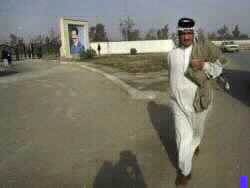U.N. Teams Head Toward Iraq Uranium Mine
10/12/2002| IslamWeb

International nuclear monitors drove six hours across the Iraqi desert to a remote uranium mining site in one of five inspections mounted Tuesday, a marked expansion of the U.N. field operation. Still more inspectors were flying to Iraq later in the day. Iraq's chief liaison to the U.N. teams, meanwhile, told a Baghdad newspaper the Iraqis have found the inspectors to be working in a "calm and professional" manner. But he again complained about last week's surprise inspection of one of Saddam Hussein's palaces, calling it an American-inspired provocation.
Tuesday marked the end of the second week of field missions for the U.N. inspectors, who have returned to Iraq after a four-year absence under a Security Council resolution requiring the Baghdad government to give up any remaining chemical or biological weapons, and shut down any programs to make them. Iraq denies it still has such weapons or programs.
The Iraq field missions were expanding as U.N. analysts began combing through 12,000 pages of documents submitted by Iraq to the United Nations over the weekend, detailing past programs of weapons of mass destruction and what it says are purely civilian programs today in the chemical, biological and nuclear areas.
Inspections in the 1990s, after Iraq's defeat in the Gulf War , led to the destruction of tons of chemical and biological weapons, and to the dismantling of Iraq's program to try to build atomic bombs.
Tuesday, reporters followed several cars of U.N. nuclear experts to mining operations at Ashakat, in the desert near the Syrian border 250 miles west of Baghdad. The enormous complex surrounded by antenna posts, some broken, sat in an otherwise empty quarter of the desert. Reporters were unable to follow the inspectors inside.
The U.N. team presumably wanted to assess current Ashakat operations in the light of what was found there by U.N. nuclear inspectors in the 1990s.
In the 1980s, the phosphate deposits at Ashakat had been exploited for their uranium content as well as for fertilizer, producing some 100 tons of uranium over six years.
Also Tuesday, other nuclear inspectors headed again for al-Tuwaitha, Iraq's major nuclear research center, 15 miles southeast of Baghdad, Iraqi Information Ministry officials reported. It was their third recent visit to the sprawling complex, where Iraqi scientists in the 1980s worked on developing technology for enriching uranium to levels usable in bombs.
A third U.N. team was reported to have gone to a veterinary medicine establishment at Abu Ghraib, just west of Baghdad - presumably the Amariyah Serum and Vaccine Institute, site of biological weapons-related research in the 1980s.
That institute is reported to have expanded its storage capacity, to an extent the U.S. government says exceeds Iraq's needs. Iraq contends the facility only makes and stores human vaccines.
Other inspectors were reported to have gone Tuesday to a military training center in Baghdad and to an industrial facility at al-Furat, just south of the Iraqi capital. The purposes of those visits were not immediately known.
In London, Prime Minister Tony Blair said it would be "naive" to believe Saddam plans to comply with U.N. demands for his disarmament in the field of weapons of mass destruction.
In an interview with the Financial Times, Blair also restated the readiness of the United States and Britain to take military action against Saddam.
"If there is a breach and Saddam doesn't comply, then we are prepared to take action," Blair was quoted as saying.
Later Tuesday, about 25 additional inspectors were scheduled to arrive on a flight from a U.N. rear base on the Mediterranean island of Cyprus, bolstering the U.N. inspection staff to approximately 70. Inspection team leaders have said they hope to expand operations to eight teams by year's end.
In an interview published Tuesday in the weekly al-Rafidayn, Lt. Gen. Hossam Mohammed Amin, chief Iraqi liaison, said of the inspectors' "behavior" that "we're satisfied with it so far because it is calm and professional."
Iraqi officials have complained sharply, however, about the U.N. inspection Dec. 3 of Baghdad's al-Sajoud palace, one of Saddam's many presidential palaces. Amin reiterated that criticism.
"The visit took place under pressure from the United States of America to create a crisis or confrontation between Iraq and inspection teams, but this did not happen," he asserted.
Such palace inspections contributed to the U.N.-Iraqi tensions that ended with the collapse of the previous inspection regime in 1998. The new U.N. resolution declares the monitors have unrestricted power to inspect such sites.
Asked how long he expects the new U.N. inspections to take, Amin said that if the inspection agencies are "sincere," he thinks they should take eight months.
"Then the Security Council should suspend the sanctions imposed on Iraq and the monitoring process would continue," he said.
He was referring to international economic sanctions imposed on Iraq after it invaded Kuwait in 1990, and to U.N. plans to establish a long-term system of monitoring Iraq's military-industrial complex - via surveillance gear, required reports and periodic visits.
PHOTO CAPTION
An Iraqi man walks past the main gate of the Iraqi Nuclear Energy Organization facility in Tuwaitha some 25 kilometers (16 miles) south east of Baghdad Monday Dec. 9 , 2002 during a visit by U.N. weapons inspectors. (AP Photo/Nasser Nasser)
www.islamweb.net
